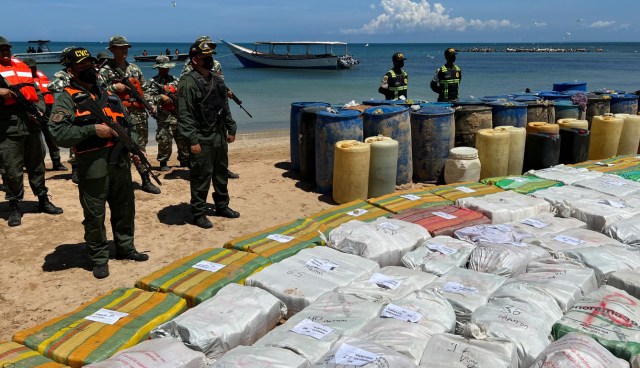
Seizures of marijuana shipments on Venezuela’s coast and along its border with Colombia have underscored the country’s role as an important corridor for a particular type of Colombian cannabis flooding Latin América’s markets.
By Insight Crime
Mar 30, 2023
In early March, Colombian National Police seized 2.5 tons of marijuana from a truck carrying kitchen utensils and plastic furniture in the municipality of Maicao, in the border department of La Guajira, on the Colombia-Venezuela border.
The Colombian National Police’s Anti-Narcotics Directorate (Dirección de Antinarcóticos de la Policía Nacional de Colombia – DIRAN), reported that the shipment was destined for Venezuela and other countries in Central America.
Days later, Venezuelan authorities announced the seizure of 457 kilograms of marijuana abandoned off the coast of Falcón State in the Caribbean Sea.
These seizures were in addition to those made in Venezuela at the end of 2022, including a seizure of more than 3.4 tons on December 15, which authorities reported was the largest marijuana seizure made in Venezuela in the last decade.
Including this seizure, some 7.6 tons of marijuana were seized between September and December 2022 across multiple operations along Venezuela’s northern coast. In total, approximately 10 tons of marijuana were seized in Venezuelan in 2022 according to media monitoring by InSight Crime and a report by Venezuela’s National Anti-drugs Superintendence (Superintendencia Nacional Antidrogas – SUNAD).
The lack of large-scale cannabis cultivation in Venezuela indicates the majority of the drugs moving through and being seized in the country come from the northern mountains of Colombia’s western Cauca department, official sources and independent reports have found.
Regional demand for Colombian-produced marijuana, especially “creepy” marijuana, which has high THC levels, is driving these large-scale seizures in Venezuela. Venezuela is the perfect waypoint between Colombia and multiple other regional markets.
Venezuela’s history as a drug corridor plays into the hands of marijuana traffickers. It’s a well-established transnational cocaine trafficking route, where the systematic involvement of high-level political and military officials in drug trafficking offers a level of security to those seeking to export abroad.
Likewise, Venezuela’s strategic location on the continent offers maritime connections with several Caribbean nations, river and land corridors with Brazil, as well as nearby routes to Central American countries.
Creepy marijuana from Cauca moves along Colombian roads to cities including Cali, Bogotá and Medellín, where it is temporarily stored before being distributed to Colombian border departments, especially Norte de Santander, La Guajira, and Vichada.
To buy marijuana in Cauca, criminal networks must negotiate with the Western Coordinating Command (Comando Coordinador de Occidente – CCO), one of the dissident factions of the now defunct Revolutionary Armed Forces of Colombia (Fuerzas Armadas Revolucionarias de Colombia – FARC), also known as the ex-FARC mafia, which dominates cannabis cultivation in the área.
Once the marijuana enters Venezuelan territory, it is moved to the states of Falcón, Sucre, or Nueva Esparta, to be loaded onto boats bound for Caribbean markets.
Beyond serving as a stepping stone to Central and North American markets, Caribbean nations such as Trinidad & Tobago and the Bahamas have also recorded arrests of Colombian citizens with large quantities of marijuana from Colombia.
According to a local military officer, an investigator, and a local fisher working near informal disembarkation points in Falcón State, who spoke to InSight Crime on condition of anonymity for security reasons, the authorization of drug shipments and control of the boats in Falcón falls to a group known as the Camacaro Cartel. The group has high-level political connections and replaced the Paraguaná Cartel after the capture of its leader, Chiche Smith.
Further south, the three main Brazilian criminal organizations have also acquired Colombian marijuana.
The Red Command (Comando Vermelho – CV) and the First Capital Command (Primeiro Comando da Capital – PCC), the two main Brazilian prison gangs, bring marijuana through the Río Negro basin on the Colombian-Venezuelan border and then into the northern state of Roraima.
The Family of the North (Familia do Norte – FDN), a smaller gang with a presence in the State of Amazonas in Brazil, has used the Orinoco River to move marijuana from the department of Vichada in Colombia, through Venezuela’s Amazonas department, and onto Brazilian soil.
This cross-border corridor is overseen by the Acacio Medina Front, another ex-FARC mafia faction, that controls movement along important corridors in the Venezuelan state of Amazonas, which borders Brazil. The group is considered one of the main links and distributors for Brazilian mafias along this jungle region.
In addition to large-scale shipments, specialized drug trafficking networks also move marijuana in small quantities. In private vehicles with secret compartments or by means of human couriers, the marijuana passes through illegal border crossings, also known as “trochas,” to be stored in warehouses in Venezuelan territory and finally sent by boat to the Caribbean coast of the country.
While it is true that criminal groups must bear high transportation costs to cross Colombia and deposit the drugs on Venezuelan soil, the expenses do not compare to the huge profits this business generates. While a kilogram of “creepy” marijuana is worth $42 in the Cauca mountains, its price in Brazil can reach $2,800.
…
Read More: Insight Crime – Venezuela Becomes Colombia’s “Creepy” Marijuana Drug Corridor
…

